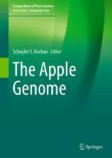Search
Search Results
-
MdPRX34L, a class III peroxidase gene, activates the immune response in apple to the fungal pathogen Botryosphaeria dothidea
Main conclusionMdPRX34L enhanced resistance toBotryosphaeria dothidea by increasing salicylic acid (SA) and abscisic acid (ABA) content as well as...
-
Biocontrol of Diplodia bulgarica, the causal agent of apple canker, using Trichoderma zelobreve
Apple ( Malus domestica Borkh) is one of the most consumed and nutritious fruits. Iran is one of the main producers of the apple in the world. Diplodia...

-
Control of coptis root rot by combination of Bacillus cereus isolate Y9 and other antagonistic microorganisms
Root rot is a destructive soil-borne disease of Coptis chinensis , which depends on chemical control at present, and more attention should be paid to...

-
Identification and characterization of the Bacillus atrophaeus strain J-1 as biological agent of apple ring rot disease
Bacillus species are promising agents for the biological control of postharvest diseases. Based on the morphological, physiological and biochemical...

-
Colletotrichum species causing anthracnose disease in A. andraeanum, manifested as spathe rot also in addition to spadix rot and leaf spot.
Anthurium is an ornamental flowering plant, cultivated in tropical and sub-tropical climates. Anthracnose is a major disease in anthurium, known to...

-
Mild Pretreatment Combined with Fed-Batch Strategy to Improve the Enzymatic Efficiency of Apple Pomace at High-Solids Content
This a two-part study was conducted to improve the enzymatic saccharification of apple pomace (AP) by pretreatment and fed-batch enzymatic...

-
Melatonin enhances resistance to Botryosphaeria dothidea in pear by promoting jasmonic acid and phlorizin biosynthesis
Ring rot, caused by Botryosphaeria dothidea , is an important fungal disease of pear fruit during postharvest storage. Melatonin, as a plant growth...

-
Subcellular level impact of extractives on brown rot decay of Norway spruce elucidated by confocal Raman microscopy and multivariate data analysis
The influence of heartwood extractives on the chemical changes occurring during the first two weeks of brown rot decay of Norway spruce ( Picea abies) ...

-
A novel rubber tree PR-10 protein involved in host-defense response against the white root rot fungus Rigidoporus microporus
BackgroundWhite root rot disease in rubber trees, caused by the pathogenic fungi Rigidoporus microporus , is currently considered a major problem in...

-
Regulatory Sequences in Apple
Apple (Malus × domestica Borkh.) is one of the most important cultivated fruit trees in the world. However, studies on apple gene regulation have...
-
Antimicrobial and antioxidant activities of Bacillus mojavensis I4 lipopeptides and their potential application against the potato dry rot causative Fusarium solani
Lipopeptides are diverse metabolites produced by various bacterial and fungal genera. They are known for their antimicrobial and surfactant...

-
Plant pathogenic Paramyrothecium species: distribution, biology, epidemiology and disease management
Paramyrothecium comprises saprobic and plant pathogenic members. Eight plant-pathogenic Paramyrothecium species have been recorded in Asia, America,...

-
Biocontrol ability of marine yeasts against postharvest diseases in mangos caused by Colletotrichum gloeosporioides and Lasiodiplodia theobromae
Anthracnose and stem-end rot are among the most devastating pathogens affecting mangos, leading to significant losses due to rotting during storage....

-
Effect of darkness treatment on the morphology, hormone status and gene expression of develo** adventitious root in apple rootstock
Adventitious root (AR) formation plays a critical role for the clonal propagation of horticultural crops. In this study, Malus prunifolia var. ringo...

-
Biphenyls and dibenzofurans of the rosaceous subtribe Malinae and their role as phytoalexins
Main conclusionBiphenyl and dibenzofuran phytoalexins are differentially distributed among species of the rosaceous subtribe Malinae, which includes...

-
Plant and Weather Factors on Resistance of Saccharum officinarum Germplasm Against Ring Spot Disease
Ring spot caused by Leptosphaeria sacchari is a very common disease of sugarcane in humid tropical conditions. We have conducted a detailed study on...

-
Genomics of Biotic Stress Resistance in Malus Domestica
Apple is one of the major horticulture crops of the world. Being a perennial crop, apple production is widely challenged by constant biotic and...
-
Insect netting: effect of mesh size and shape on exclusion of some fruit pests and natural enemies under laboratory and orchard conditions
To improve exclusion systems for fruit trees, insect nets of various types were evaluated for their permeability to different beneficial and pest...

-
Comparative genomics of Botryosphaeria dothidea and B. kuwatsukai, causal agents of apple ring rot, reveals both species expansion of pathogenicity-related genes and variations in virulence gene content during speciation
Ring rot, one of the most destructive diseases of apple worldwide, is caused primarily by Botryosphaeria dothidea and 8. kuwatsukai. Here, we...

-
Investigation of the antifungal effects of algal extracts on apple-infecting fungi
It is known that cell extracts of various algae have antifungal activity against microorganisms in vitro. Antifungal activities of Ulva lactuca , Chlore...

